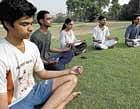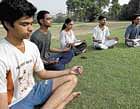

Om Parkash Prabhu (28), a social worker who also runs a travel agency in Mumbai, was stuck in a dark tunnel with no light in sight. His stress level had shot up enormously. He would often get headaches and chest pain, and had not slept for several months. But tests in three reputed hospitals of Mumbai and Pune found nothing wrong in his system. Prabhu, the only son of an agrarian couple from Sindhudurg, felt he would die a slow death. It was then that a friend of his, Radheshyam, a documentary film maker, told him about Vipassana meditation. The latter had just returned from Leh after doing a 10-day Vipassana course. Prabhu hardly had an option. He had already tried various streams of medicine and yoga.
Recently, he attended a 10-day Vipassana course in Mclaudganj, the Tibetan settlement above Dharamshala. And the consequences are myriad and nothing but constructive. “Finally, I am enjoying sound sleep. Besides, I feel much more relaxed now,” he says, singing paeans for Vipassana. Prabhu is even learning through meditation to take small setbacks into his stride. “When I was in Mclaudganj, a friend won over a girl I was pursuing back home. But I have no regrets. Let him have the girl, I have Vipassana,” he says, displaying poise of a yogi.
Like Prabhu, there are 10 lakh others who have benefitted in one way or the other from the Vipassana in over three decades. According to Dhananjay Chavan, a trained psychiatrist and senior Vipassana teacher, about seven lakh are below the age of 40. Such is the dominance of youth in Vipassana centres that Aseem Chawla (53), former head of a travel company who attended the course with Prabhu in Mclaudganj, felt like the odd man out. “I was the oldest person there. Youth is the ‘in thing’ in Vipassana,” notes Chawla, who lost his reading, writing and talking faculties after a stroke in January 2005, and is now on recovery mode.
Besides Prabhu, Chawla and about a dozen others, the rest of the 80 male and female meditators in Mclaudganj were foreigners from United States of America, United Kingdom, Italy, France, Spain, Russia and other countries that have been rocked by recession, shutdowns and depression. And an overwhelming majority of them was young. Austin (25 plus) from Boston who sat for the 10-day long course lost his job as a waiter before he decided to go on the spiritual expedition. Armando Uribe (24), an architecture student from Mexico, opted to go ‘inside’ after his final examination before exploring the outer world. “I did my first course in Mexico. It helps in a big way,” he claims, looking calm and composed.
What attracts youth in hordes to Vipassana is its non-sectarian, scientific and action-oriented approach. Moreover, it is taught free of cost with charities taking care of boarding and lodging expenses. The technique owes allegiance to no organised religion and promotes no dogmas. P L Dhar, a senior Vipassana teacher and professor of IIT (Indian Institute of Technology) Delhi, credits the meditation technique’s popularity among youth and science community to its problem-solving potential.
“It is devoid of religiosity, rites and rituals. They (youth and rationalists) find it scientific. The spiritual discourses by many other gurus on the other hand, have a strong element of religiosity and devotion,” Dhar contends. He started doing Vipassana in 1985 and since then conducted several courses in Tihar central jail and other places. The popularity of Vipassana among the science community can be gauged from the fact that out of its 1200 teachers, according to Chavan, about one third are medical doctors, engineers, psychologists and psychiatrists.
The meditation technique that teaches one to be aware and equanimous in all the ups and downs of life is taught in over 150 centres in the country and abroad. An ancient technique, Vipassana was supposed to have got lost from India after Gautama, the Buddha, rediscovered it in 6th BC. S N Goenka, the principal teacher of Vipassana, who is credited with setting up the Vipassana centres, brought it back to India from Myanmar about 33 years back.
Practical tools
Like Vipassana, Art of Living — a spiritual NGO spearheaded by Sri Sri Ravi Shankar — also enjoys large following among the youth in India and abroad. Over half of the seven courses run by the Art of Living are designed to help children, teenagers, college students and professionals cope with the expectations in studies, relationships and job. “The needs and demands of the 18-40 age group are quite different from the 40-plus. They are struggling to manage relationships and pressure of studies and jobs. We have practical tools to help them. This is what makes Art of Living attractive to the youth,” says Avinash Tiku, a young, full-time teacher with the NGO, who has taught Yes+ courses (course for youth) in Mumbai, Delhi, IIM Kolkata, Dehradun, Ludhiana and Solan (Himachal Pradesh).
Tiku claims that over 1,20,000 youth in the country practice pranayam and meditation prescribed under the Art of Living courses. Out of these while 60,000 are based in Mumbai, 20,000 come from Delhi. Bangalore, the high-tech metro, contributes over 7000 to the NGO.
The Art of Living, like Vipassana, has nothing to do with an organised religion. It is more of a personality development programme which helps one to de-stress. “There is no religion in it. It is spiritualism. It cleanses, empowers, increases energy level and tells one how to manage time,” says Tiku.
Shreya Saklani, who is pursuing post-graduation in Mathematics from IIT Delhi and has been practicing mediation for seven years, agrees with Tiku. Shreya asserts that regular meditation has upped her concentration and confidence level. “When I was in class 12, I was not doing very well. My mother told me about the Art of Living. I started off with a six-day course and have since done seven courses. It gives me clarity of mind and child-like energy,” she declares. Sumit Manuprakash from Ambala, who is a Bio physics research scholar in the IIT and who has been attending the Art of Living for four years, calls it a stress eliminator.
Nitin Arora, a research scholar in the IIT Delhi and teacher of Yes+ course, claims that meditation can cause miracles. Arora, who did his Masters in Computer Sciencefrom New York, cites his own experience: “I was hit by a bus in Bangalore. My jaw got displaced and I was on a liquid diet for long. The jaw was fixed on its own.” Arora feels that the meditation has helped him get over stage fright. “Earlier, I could not give presentations in class. And now, I address 100 students every day,” he avers. According to him, there are more than 40 Art of Living centres in Delhi and a good percentage of students in the IIT Delhi and the Delhi University practice meditation.
The Art of Living runs courses for children, teens, youth, corporate and other segments of the society in its dozen national and international centres. Besides, the teachers of the foundation teach yoga and meditation in various local centres, universities and other institutes of education. It has its presence in all metros, tier-II cities and even villages (runs Utsav programmes for rural youth). It runs basic as well as advanced courses. All its courses carry a fee. While the minimum fee is Rs 700, the maximum may run into several thousand.
Introspective approach
Unlike the Art of Living, Soka Gakkai, based on Japanese Buddhist sage Nichiren Daishonin’s (1222-1282) humanistic philosophy, is voluntary and involves no fees. Bharat Soka Gakkai (BSG), an affiliate of Soka Gakkai International (SGI), headquartered in South Delhi, is the nodal office of the International NGO in the Indian capital.
The primary clientele of the technique comprises youth. “We have 42,000 members in the country. Out of this 60 percent are youth and women. Since our focus is on inner-self, absolute happiness and stability, and the approach is introspective, pro-active and positive, the youth finds it attractive,” says Navina Reddi, Director General of the BSG. The system involves chanting based on Lotus sutra, considered the highest teaching of Gautama, the Buddha.
Though Soka Gakkai has its origin in Buddhist philosophy, the BSG does not believe in isms. “A person joining us does not become a Buddhist. There is no conversion here. We are an NGO working for peace, culture and education,” Reddi emphasises. The Soka Gakkai is more of an urban phenomenon with half of its membership coming from Delhi alone.
The BSG has hundreds of chapters in Delhi. Moksha Nagdev (23), a clinical psychologist in South Delhi who has been practicing the technique since March this year, finds it magical. Nagdev, who specialises in child psychology, was under a lot of stress and guided to Soka Gakkai by her teacher. She says the daily chanting frees her from evil thoughts and stress. “I have got my answers from the practice. I’ve got the right perspective. Now I believe in the power of the mind. The practice gives me my fuel to go through life. I am more aware of my feelings,” Nagdev claims.
Aparna (33), a woman entrepreneur who runs an interactive company in South Delhi, feels Soka Gakkai helps her tackle daily problems. Aparna has been a regular at it for around eight years. What appeals to her is that the system has no guru and does not worship a deity. Nagdev too calls it a ‘spiritual quest’ rather than a faith. The system prescribes no timeframe and is flexible when it comes to daily practice. But it takes no strangers because the Soka Gakkai volunteers meet at an individual’s residence. Reddi says that the chanting of Japanese mantra — Nam myoho renge kyo — may be practiced for 10 minutes to several hours.
Scientology, another system which claims to purge insecurities, painful experiences, self-doubt and despair, is relatively new to India (it arrived only in 2002). It has only a handful of centres in the country (Delhi, Patiala, Chandigarh, Kolkata, and Mohali –one is coming up in Mumbai). But when it comes to attracting youth, it has quite a lot to offer. It has courses on personality development, communication skills, relationships, technology and even ethics. It claims to decode the secret of success as well.
“We have the tools to help the youth. Our experts help people get rid of anger, grief and negative feelings through auditing. Forty to 50 percent of our 20,000 members in Delhi are young professionals and entrepreneurs,” says S Johnson Singh, Public Division in charge in South Delhi centre of Scientology. The fees of the scientology centres are on the higher side with a 25-hour long auditing course costing Rs 10,000.
On the face of it, scientology looks to be a complex practice. Shaily, PRO in the South Delhi centre, admits that a new candidate may find it complex in the first go but will find it easy later. “It is well-defined. There is even a way of how one should read about it,” she argues. According to her, people from all walks of life and age-groups are into scientology. A number of Hollywood film stars including John Travolta, Tom Cruise, Nicole Kidman and Kirstie Alley are said to be promoters of scientology.
Although scientology claims to be a religion and even has a church of scientology in the US, Singh claims it has nothing to do with Christianity or any other religion. “Ours is a non-profit NGO. We teach life improvement skills. Anyone can become a scientologist,” she says.